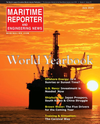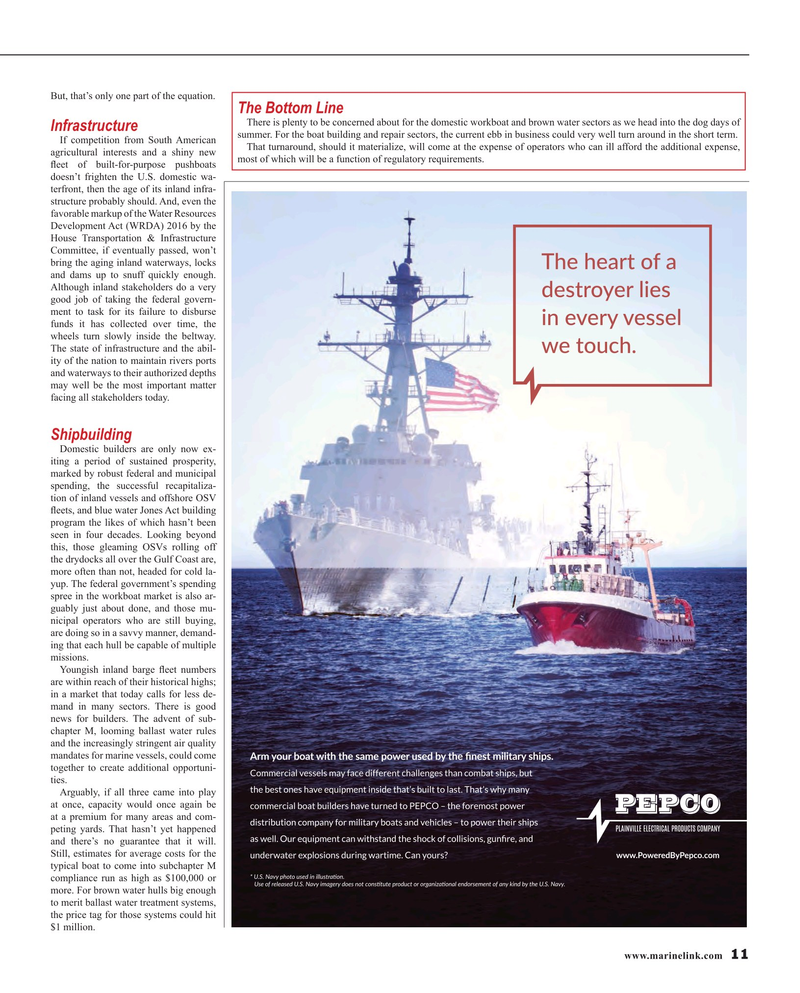
Page 11: of Maritime Reporter Magazine (June 2016)
Annual World Yearbook
Read this page in Pdf, Flash or Html5 edition of June 2016 Maritime Reporter Magazine
But, that’s only one part of the equation.
The Bottom Line
There is plenty to be concerned about for the domestic workboat and brown water sectors as we head into the dog days of
Infrastructure summer. For the boat building and repair sectors, the current ebb in business could very well turn around in the short term.
If competition from South American
That turnaround, should it materialize, will come at the expense of operators who can ill afford the additional expense, agricultural interests and a shiny new most of which will be a function of regulatory requirements. ? eet of built-for-purpose pushboats doesn’t frighten the U.S. domestic wa- terfront, then the age of its inland infra- structure probably should. And, even the favorable markup of the Water Resources
Development Act (WRDA) 2016 by the
House Transportation & Infrastructure
Committee, if eventually passed, won’t bring the aging inland waterways, locks
The heart of a and dams up to snuff quickly enough.
Although inland stakeholders do a very destroyer lies good job of taking the federal govern- ment to task for its failure to disburse in every vessel funds it has collected over time, the wheels turn slowly inside the beltway.
The state of infrastructure and the abil- we touch.
ity of the nation to maintain rivers ports and waterways to their authorized depths may well be the most important matter facing all stakeholders today.
Shipbuilding
Domestic builders are only now ex- iting a period of sustained prosperity, marked by robust federal and municipal spending, the successful recapitaliza- tion of inland vessels and offshore OSV ? eets, and blue water Jones Act building program the likes of which hasn’t been seen in four decades. Looking beyond this, those gleaming OSVs rolling off the drydocks all over the Gulf Coast are, more often than not, headed for cold la- yup. The federal government’s spending spree in the workboat market is also ar- guably just about done, and those mu- nicipal operators who are still buying, are doing so in a savvy manner, demand- ing that each hull be capable of multiple missions.
Youngish inland barge ? eet numbers are within reach of their historical highs; in a market that today calls for less de- mand in many sectors. There is good news for builders. The advent of sub- chapter M, looming ballast water rules and the increasingly stringent air quality mandates for marine vessels, could come ul?o?u0o-|?b|_|_;v-l;ro?;u?v;70?|_;Cm;v|lb?b|-u?v_brvl together to create additional opportuni-
Commercial vessels may face different challenges than combat ships, but ties. the best ones have equipment inside that’s built to last. That’s why many
Arguably, if all three came into play at once, capacity would once again be commercial boat builders have turned to PEPCO – the foremost power at a premium for many areas and com- distribution company for military boats and vehicles – to power their ships
PLAINVILLE ELECTRICAL PRODUCTS COMPANY peting yards. That hasn’t yet happened
EW[IPP3YVIUYMTQIRXGER[MXLWXERHXLIWLSGOSJGSPPMWMSRWKYRcVIERH and there’s no guarantee that it will.
Still, estimates for average costs for the ???lo?;u;7?;r1ol1ol underwater explosions during wartime. Can yours? typical boat to come into subchapter M
R&?"?-??r_o|o?v;7bmb???v|u-?om? compliance run as high as $100,000 or &v;o=u;?;-v;7&?"?-??bl-];u?7o;vmo|1omv?|?|;ruo7?1|ouou]-mb?-?om-?;m7ouv;l;m|o=-m?hbm70?|_;&?"?-???
more. For brown water hulls big enough to merit ballast water treatment systems, the price tag for those systems could hit $1 million. www.marinelink.com 11
MR #6 (10-17).indd 11 6/6/2016 12:18:36 PM

 10
10

 12
12
